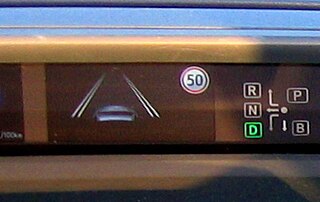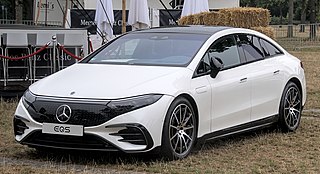
A self-driving car, also known as an autonomous car (AC), driverless car, robotic car or robo-car, is a car that is capable of operating with reduced or no human input. Self-driving cars are responsible for all driving activities including perceiving the environment, monitoring important systems, and controlling the vehicle, including navigating from origin to destination.

The Mercedes-Benz S-Class, formerly known as Sonderklasse, is a series of full-sized luxury sedans, limousines and armored sedans produced by the German automaker Mercedes-Benz. The S-Class is the designation for top-of-the-line Mercedes-Benz models and was officially introduced in 1972 with the W116, and has remained in use ever since. The S-Class is one of the flagship vehicles for Mercedes-Benz.

Vehicular automation involves the use of mechatronics, artificial intelligence, and multi-agent systems to assist the operator of a vehicle such as a car, lorries, aircraft, or watercraft. A vehicle using automation for tasks such as navigation to ease but not replace human control, qualify as semi-autonomous, whereas a fully self-operated vehicle is termed autonomous.
Ernst Dieter Dickmanns is a German pioneer of dynamic computer vision and of driverless cars. Dickmanns has been a professor at Bundeswehr University Munich (1975–2001), and visiting professor to Caltech and to MIT, teaching courses on "dynamic vision".

Automatic parking is an autonomous car-maneuvering system that moves a vehicle from a traffic lane into a parking spot to perform parallel, perpendicular, or angle parking. The automatic parking system aims to enhance the comfort and safety of driving in constrained environments where much attention and experience is required to steer the car. The parking maneuver is achieved by means of coordinated control of the steering angle and speed which takes into account the actual situation in the environment to ensure collision-free motion within the available space.

Adaptive cruise control (ACC) is a type of advanced driver-assistance system for road vehicles that automatically adjusts the vehicle speed to maintain a safe distance from vehicles ahead. As of 2019, it is also called by 20 unique names that describe that basic functionality. This is also known as Dynamic cruise control.

The Eureka PROMETHEUS Project was the largest R&D project ever in the field of driverless cars. It received €749,000,000 in funding from the EUREKA member states, and defined the state of the art of autonomous vehicles. Numerous universities and car manufacturers participated in this Pan-European project.

A collision avoidance system (CAS), also known as a pre-crash system, forward collision warning system (FCW), or collision mitigation system, is an advanced driver-assistance system designed to prevent or reduce the severity of a collision. In its basic form, a forward collision warning system monitors a vehicle's speed, the speed of the vehicle in front of it, and the distance between the vehicles, so that it can provide a warning to the driver if the vehicles get too close, potentially helping to avoid a crash. Various technologies and sensors that are used include radar (all-weather) and sometimes laser (LIDAR) and cameras to detect an imminent crash. GPS sensors can detect fixed dangers such as approaching stop signs through a location database. Pedestrian detection can also be a feature of these types of systems.

Traffic-sign recognition (TSR) is a technology by which a vehicle is able to recognize the traffic signs put on the road e.g. "speed limit" or "children" or "turn ahead". This is part of the features collectively called ADAS. The technology is being developed by a variety of automotive suppliers. It uses image processing techniques to detect the traffic signs. The detection methods can be generally divided into color based, shape based and learning based methods.
VisLab is an Italian company working on computer vision and environmental perception for vehicular applications. It was founded in the early 90s as a research laboratory at University of Parma. It started its activities in 1990, with its involvement in the Eureka PROMETHEUS Project. Since then the research group has focused on vehicular applications.

Alberto Broggi is General Manager at VisLab srl and a professor of Computer Engineering at the University of Parma in Italy.
VIAC, the VisLab Intercontinental Autonomous Challenge, is the challenge conceived by VisLab as an extreme test of autonomous vehicles. It ran from July 20, 2010 to October 28, 2010, involving four driverless vehicles driving with virtually no human intervention on an almost 16,000 kilometres (9,900 mi) trip from Parma, Italy to Shanghai, China.

A driverless tractor is an autonomous farm vehicle that delivers a high tractive effort at slow speeds for the purposes of tillage and other agricultural tasks. It is considered driverless because it operates without the presence of a human inside the tractor itself. Like other unmanned ground vehicles, they are programmed to independently observe their position, decide speed, and avoid obstacles such as people, animals, or objects in the field while performing their task. The various driverless tractors are split into full autonomous technology and supervised autonomy. The idea of the driverless tractor appears as early as 1940, but the concept has significantly evolved in the last few years. The tractors use GPS and other wireless technologies to farm land without requiring a driver. They operate simply with the aid of a supervisor monitoring the progress at a control station or with a manned tractor in lead.

Experiments have been conducted on self-driving cars since 1939; promising trials took place in the 1950s and work has proceeded since then. The first self-sufficient and truly autonomous cars appeared in the 1980s, with Carnegie Mellon University's Navlab and ALV projects in 1984 and Mercedes-Benz and Bundeswehr University Munich's Eureka Prometheus Project in 1987. Since then, numerous major companies and research organizations have developed working autonomous vehicles including Mercedes-Benz, General Motors, Continental Automotive Systems, Autoliv Inc., Bosch, Nissan, Toyota, Audi, Volvo, Vislab from University of Parma, Oxford University and Google. In July 2013, Vislab demonstrated BRAiVE, a vehicle that moved autonomously on a mixed traffic route open to public traffic.
Roborace was a competition with autonomously driving, electrically powered vehicles. Founded in 2015 by Denis Sverdlov, it aimed to be the first global championship for autonomous cars. From 2017 to 2019, the official CEO was 2016–17 Formula E champion, Lucas Di Grassi, who later became a member of Roborace’s supervisory board. The series tested their technology and race formats at FIA Formula E Championship events during 2016–2018. In 2019 Roborace organized Season Alpha, which consisted of 4 trial racing events with several independent teams competing against each other for the first time. In 2020–21 Roborace held Season Beta with 7 competing teams. All teams utilized the same chassis and powertrain, but they had to develop their own real-time computing algorithms and artificial intelligence technologies.
Autonomous things, abbreviated AuT, or the Internet of autonomous things, abbreviated as IoAT, is an emerging term for the technological developments that are expected to bring computers into the physical environment as autonomous entities without human direction, freely moving and interacting with humans and other objects.
Cruise LLC is an American self-driving car company headquartered in San Francisco, California. Founded in 2013 by Kyle Vogt and Dan Kan, Cruise tests and develops autonomous car technology. The company is a largely autonomous subsidiary of General Motors. Following a series of incidents, it suspended operations in October 2023, and the CEO resigned in November 2023.

A self-driving truck, also known as an autonomous truck or robo-truck, is an application of self-driving technology aiming to create trucks that can operate without human input. Alongside light, medium, and heavy-duty trucks, many companies are developing self-driving technology in semi trucks to automate highway driving in the delivery process.

The Mercedes-Benz EQS (V297) is a battery electric full-size luxury liftback car produced by German automobile manufacturer Mercedes-Benz Group. It was released in September 2021 in Germany and the fourth quarter of the year in the United States. As a battery-electric vehicle, it is part of the Mercedes-Benz EQ family.
Regulation of self-driving cars, autonomous vehicles and automated driving system is an increasingly relevant topic in the automotive industry strongly related to the success of the actual technology. Multiple countries have passed local legislation and agreed on standards for the introduction of autonomous cars.












